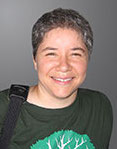A Revolution in Math Education – Why It’s Different This Time
by Sarah Lonberg-Lew
At the Adult Numeracy Center at TERC, we are big fans of the work of Stanford Professor Dr. Jo Boaler. Dr. Boaler has taken the groundbreaking work of psychologist Carol Dweck on “mindset” and built an organization aimed at revolutionizing the way math is taught. Her organization, YouCubed.org, promotes teaching math as an open, visual, creative subject, focusing on building strong conceptual understanding over ability to reproduce procedures quickly. Most importantly, YouCubed encourages math educators to work to cultivate a “growth mindset” in their students. Simply put, a growth mindset means the awareness that the brain can grow. With hard work and conceptually rich experiences, our brains can become better at math – something many people believe is not possible for them.
Dr. Boaler ends emails to YouCube’s subscribers with the words, “Viva la revolution” because this really is a revolutionary approach to math education, and in our own little corner of the math education world, we at the Adult Numeracy Center are a part of it. Many of our adult learners have been very hurt by a traditional approach to math education that focuses on speed and ability to memorize – and conflates those qualities with intelligence. They deserve a chance to realize their own mathematical potential and to reclaim what it means to be smart.
I recently had a conversation with another teacher about the distressing idea that attempts at math education reform have been going on for decades and that they are always met with resistance from teachers and parents. Ultimately, each new reform attempt fades away, only to be replaced with the next. People still talk derisively about the “new math” of the 1960s and how it took “easy” procedures for computation and made them unnecessarily complicated with the aim of having students understand why they were doing what they were doing and not just how to do it. One strategy for achieving this was to teach students to calculate in different bases (like base 2 or base 8) in the hopes that that would help them develop a really deep understanding of numbers and operations. This meant students were doing math that looked like nonsense to people who had learned “the old way” and was met with frustration by parents who could not make sense of their children’s homework. The things people said about the new math sounded very similar to the complaints about math education flooding the internet today. (See Tom Lehrer’s satire on the new math (below) and ask yourself if today’s parents and teachers could have written it!)
So I wondered, is what we’re doing now any different? Are we repeating history with this current attempt to reform math education? Happily, I found that the answer is that what we are doing now is different and new. There are two pieces that seem to me to be very different from previous attempts, and they give me hope.
One is that our focus now is not on showing students why they are doing what they are doing. That is only marginally more effective than teaching mnemonics for procedures. We now know that it is important for students to construct for themselves which of their strategies work and why. By beginning with an idea of the meaning of an operation, like subtraction, students have the opportunity to construct many strategies that they understand and retain because those strategies belong to them. Whether the traditional procedure we all learned in school is among those strategies depends on the student. Nobody has to be forced into being able to explain the idea of “borrowing” – they will either make sense of it or use other strategies. The important thing is that they will know when to subtract in the real world and be able to do it accurately.
The other very important difference between the “old” new math and the “new” math revolution is the idea of growth mindset and the real neuroscience that supports it. Cultivating a growth mindset in our students doesn’t just mean saying “Don’t give up! You can do it! I believe in you!” These are important messages, but more important is the idea of neuroplasticity – the ability our brains have to change how they work through effort and practice. This is a major paradigm shift and research has shown that when people develop a growth mindset, they approach their learning differently and become much more successful at learning math (or anything else!). Knowing that our brains are capable of growth empowers us to create that growth.
The current revolution may feel on the surface like old failed attempts at math education reform. Constructing understanding through visuals and flexible thinking can make the work look more complicated than traditional procedures on paper, but this is not the “new math” redux. This time we are empowering students to be their own sense-makers with the knowledge that they can grow their brains to think in new and powerful ways.
Viva la revolution!
Reference:
Boaler, J. (2013). Ability and Mathematics: the mindset revolution that is reshaping education. FORUM, 55, 1, 143-152.
==================================================

Sarah Lonberg-Lew has been teaching and tutoring math in one form or another since college. She has worked with students ranging in age from 7 to 70, but currently focuses on adult basic education and high school equivalency. She teaches in an adult education program in Gloucester, MA. Sarah’s work with the SABES Mathematics and Adult Numeracy Curriculum & Instruction PD Center at TERC includes developing and facilitating trainings and assisting programs with curriculum development. She is the treasurer for the Adult Numeracy Network.
